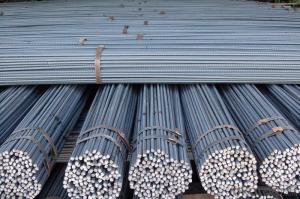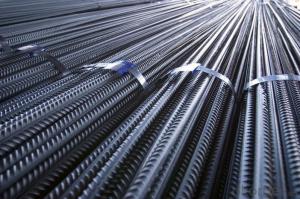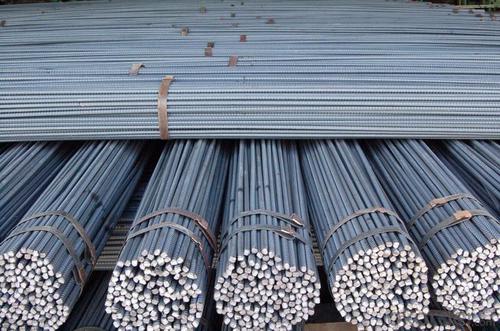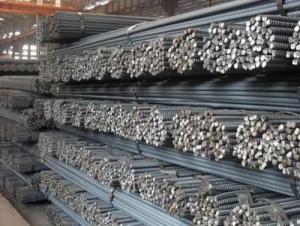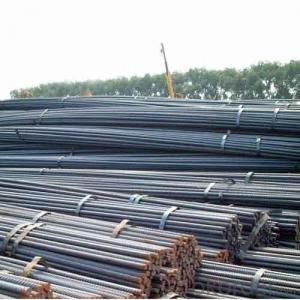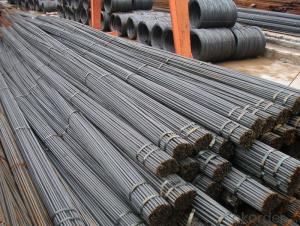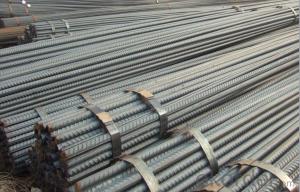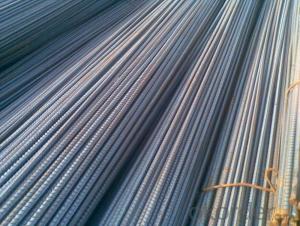Hot Rolled Carbon Steel Rebar 14mm with High Quality
- Loading Port:
- China Main Port
- Payment Terms:
- TT or LC
- Min Order Qty:
- 25 m.t.
- Supply Capability:
- 10000 m.t./month
OKorder Service Pledge
OKorder Financial Service
You Might Also Like
Product Description:
OKorder is offering Hot Rolled Carbon Steel Rebar 14mm with High Quality at great prices with worldwide shipping. Our supplier is a world-class manufacturer of steel, with our products utilized the world over. OKorder annually supplies products to European, North American and Asian markets. We provide quotations within 24 hours of receiving an inquiry and guarantee competitive prices.
Product Applications:
Hot Rolled Carbon Steel Rebar 14mm with High Quality is widely used in buildings, bridges, roads and other engineering construction. Big to highways, railways, bridges, culverts, tunnels, public facilities such as flood control, dam, small to housing construction, beam, column, wall and the foundation of the plate, deformed bar is an integral structure material. With the development of world economy and the vigorous development of infrastructure construction, real estate, the demand for deformed bar will be larger and larger..
Product Advantages:
OKorder's Hot Rolled Carbon Steel Rebar 14mm with High Quality are durable, strong.packed and suitable for construction
Main Product Features:
· Premium quality
· Prompt delivery & seaworthy packing (30 days after receiving deposit)
· Can be recycled and reused
· Mill test certification
· Professional Service
· Competitive pricing
Product Specifications:
Manufacture: Hot rolled
Grade: HRB335 HRB400 BS4449 Grade460 ASTM Grade40 Grade60
Certificates: ISO, SGS, BV, CIQ
Length:6m 8m 9m 12m
Packaging: Export packing, packed by coil
FAQ:
Q1: Why buy Materials & Equipment from OKorder.com?
A1: All products offered byOKorder.com are carefully selected from China's most reliable manufacturing enterprises. Through its ISO certifications, OKorder.com adheres to the highest standards and a commitment to supply chain safety and customer satisfaction.
Q2: How do we guarantee the quality of our products?
A2: We have established an advanced quality management system which conducts strict quality tests at every step, from raw materials to the final product. At the same time, we provide extensive follow-up service assurances as required.
Q3: How soon can we receive the product after purchase?
A3: Within three days of placing an order, we will begin production. The specific shipping date is dependent upon international and government factors, but is typically 7 to 10 workdays.
Q4: Can you supply the Rebar according to the standard KS?
A4: Yes, we can supply SD400 and SD500
Q5: How to avoid the rust after deliver the goods to the loading port?
A5: We will keep the goods at the port covered with water-proof material
Images:
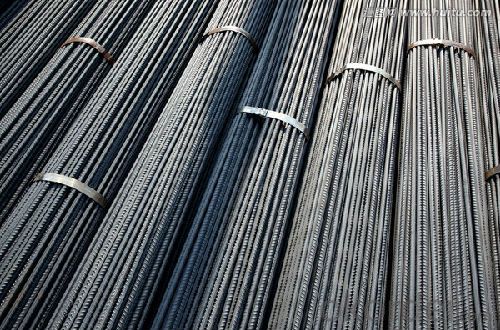
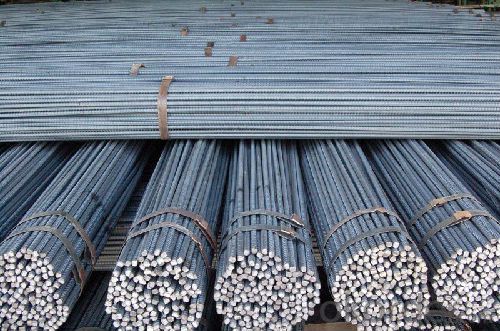
- Q: How are steel rebars protected against alkali attacks?
- Steel rebars are protected against alkali attacks by applying a protective coating or by using corrosion-resistant materials such as stainless steel rebars. Additionally, proper concrete mix design, including the use of low alkali cement and supplementary cementitious materials, can help mitigate alkali attacks on steel rebars.
- Q: How do steel rebars improve the ductility of a structure?
- Steel rebars improve the ductility of a structure by providing reinforcement and enhancing its ability to withstand tensile forces. The presence of rebars within concrete or other structural materials allows them to better absorb and distribute stress, preventing brittle failure and promoting flexural strength.
- Q: Can steel rebars be used in tunnels or underground mines?
- Yes, steel rebars can be used in tunnels or underground mines. Steel rebars are commonly used in construction projects to reinforce concrete structures, and tunnels and underground mines are no exception. Reinforcing steel bars provide additional strength and stability to the concrete used in tunnel linings or mine shafts. They help resist the forces exerted by the surrounding soil or rock, prevent cracking or collapse, and increase the overall durability and longevity of the structure. Steel rebars are selected based on their specific characteristics, such as diameter, grade, and corrosion resistance, to ensure they meet the design requirements and are suitable for the specific underground conditions.
- Q: Are there any environmental benefits to using steel rebars?
- There are numerous environmental advantages to utilizing steel rebars in construction. Here are some of the main benefits: 1. Recyclability: Steel rebars possess a high degree of recyclability, enabling them to be reused or repurposed once their lifespan in a structure comes to an end. This diminishes the need for new steel production and the associated energy consumption and greenhouse gas emissions. In fact, steel is one of the most widely recycled materials worldwide, boasting a recycling rate of approximately 90%. 2. Durability: Steel rebars are renowned for their strength and durability, granting structures a longer lifespan. This lessens the necessity for frequent replacements or repairs, resulting in reduced waste generation and the conservation of resources. 3. Energy efficiency: Steel production has become increasingly energy-efficient over time, thanks to advancements in technology and processes. This signifies that the environmental impact of steel production has been decreasing, making it a more sustainable choice in comparison to other materials. 4. Reduced deforestation: Steel rebars provide an alternative to timber reinforcement, which is often acquired through deforestation practices. By opting for steel rebars instead, we can help alleviate the pressure on forests and safeguard their invaluable ecosystem services. 5. Waste reduction: Steel rebars can be prefabricated and cut to precise lengths, minimizing waste on construction sites. Additionally, the scrap generated during the fabrication process can be recycled, further reducing waste generation. In conclusion, the utilization of steel rebars in construction offers a variety of environmental benefits, including recyclability, durability, energy efficiency, reduced deforestation, and waste reduction. These advantages contribute to a more sustainable and eco-friendly construction industry.
- Q: Can steel rebars be used in earthquake-prone areas?
- Yes, steel rebars can be used in earthquake-prone areas. Steel rebars are commonly used in construction, including in earthquake-resistant structures. The high tensile strength and ductility of steel make it a suitable material for reinforcing concrete and providing strength and stability to structures during earthquakes.
- Q: How do steel rebars provide reinforcement to concrete?
- Concrete is reinforced by steel rebars, which act as tension members. When loads are applied to the concrete, such as the weight of a structure or external forces, it tends to crack and fail under tension. To counteract this weakness, steel rebars are embedded within the concrete. Made of high-strength steel, the rebars have a much higher tensile strength than concrete. During the pouring of concrete, the rebars are strategically placed throughout the structure, typically in areas where tension forces are expected. These areas include beams, columns, and slabs. As the concrete cures and hardens, it forms a strong bond with the steel rebars. When external forces are exerted on the concrete, like the weight of a building or lateral forces from wind or earthquakes, tension forces are generated within the concrete. However, instead of causing the concrete to crack and fail, the rebars bear the majority of the tension. Due to the high tensile strength of the steel rebars, they can resist the tension forces, preventing the formation of cracks and ensuring the integrity and structure of the concrete. The rebars act as reinforcement by evenly distributing the tensile forces throughout the concrete, enhancing its overall strength and durability. Moreover, rebars offer additional benefits to concrete structures. They can mitigate the effects of temperature changes, prevent shrinkage cracks, and enhance resistance to corrosion caused by environmental factors. In conclusion, the use of steel rebars significantly improves the structural integrity and lifespan of concrete, enabling it to withstand various loads and external forces over time.
- Q: What are the guidelines for ensuring proper concrete cover over steel rebars?
- To ensure the long-term durability and performance of reinforced concrete structures, it is crucial to have the appropriate concrete cover over steel rebars. Here are some tips to achieve the correct cover: 1. Compliance with building codes and specifications is essential. These regulations establish minimum requirements for concrete cover over steel rebars to ensure structural integrity, fire resistance, and corrosion resistance. It is important to consult and adhere to the applicable codes and specifications for your project. 2. Determine the required concrete cover based on factors such as environmental conditions, exposure to aggressive agents, structural design, and reinforcement type. Structural engineers typically assess these factors to determine the necessary cover and protect the rebars adequately. 3. Carefully select the concrete mix design to achieve the desired strength, durability, and workability. Consider factors like the quality and size of aggregates, cement content, water-to-cement ratio, and use of additives or admixtures. A well-designed mix will promote proper bonding and sufficient protection of the rebars. 4. Maintain proper construction practices. This includes using appropriate formwork and reinforcement placement techniques, ensuring correct concrete placement, compaction, and curing. Proper positioning and secure tying of the rebars are crucial to maintain the required cover and prevent displacement during concrete pouring. 5. Regular inspections and monitoring during construction are necessary. Check the placement of reinforcement, cover thickness, and overall concrete quality. Address and rectify any deviations from the specified requirements promptly. 6. Protect against corrosion. Adequate concrete cover helps prevent corrosion, but additional measures can enhance durability. Consider using corrosion-resistant rebars, applying epoxy coatings, or utilizing corrosion inhibitors to further protect the reinforced concrete structure. 7. Document and maintain records of the construction process, including reinforcement placement, cover thickness, and any modifications made. This documentation will be useful for future reference, maintenance, and repairs. By following these guidelines, you can ensure the appropriate concrete cover over steel rebars, resulting in durable and structurally sound reinforced concrete structures. It is always advisable to consult with structural engineers and construction professionals to meet specific project requirements and comply with local building codes and regulations.
- Q: What is the minimum lap length required for steel rebars in concrete?
- The minimum lap length required for steel rebars in concrete varies depending on the specific design and requirements of the structure, but it is generally recommended to follow the guidelines provided by relevant building codes and standards. These guidelines consider factors such as the diameter of the rebar, the concrete strength, and the structural loadings to determine the minimum lap length necessary for ensuring proper bonding and structural integrity. It is essential to consult the appropriate building codes or a structural engineer to accurately determine the minimum lap length for steel rebars in a concrete structure.
- Q: How do steel rebars affect the overall creep and shrinkage of concrete structures?
- The overall deformation of concrete structures can be significantly affected by steel rebars. Creep, which refers to the long-term deformation of concrete under sustained load, and shrinkage, the reduction in volume during drying and hardening, are both influenced by rebars. To control and mitigate both creep and shrinkage, steel rebars play a crucial role. When embedded in concrete, rebars enhance the load-carrying capacity and provide tensile strength to the structure. This reinforcement allows for stress distribution and limits deformation over time. In terms of creep, steel rebars minimize its effects by reducing stress transferred to the concrete. By absorbing a significant portion of the load applied, rebars alleviate strain and reduce creep deformation. Furthermore, rebars help control cracking caused by creep, thus preserving the concrete's structural integrity. Regarding shrinkage, steel rebars also impact its magnitude. As concrete shrinks during drying and hardening, rebars act as restraints, preventing excessive volume reduction. By resisting contraction forces, rebars minimize the potential for cracking and maintain the concrete's structural stability. It is important to consider the type, size, and spacing of rebars as they can affect the overall impact on creep and shrinkage. Proper design and placement, including appropriate cover thickness, are necessary to ensure optimal performance and minimize long-term deformations. In conclusion, steel rebars play a vital role in controlling creep and shrinkage in concrete structures. By providing reinforcement, distributing stress, and preventing cracking, rebars maintain the structural integrity of concrete over time.
- Q: How are steel rebars bent during construction?
- Steel rebars are typically bent during construction using specialized equipment such as hydraulic benders or rebar bending machines. These machines apply force to the rebar, causing it to bend into the desired shape. The process may involve heating the rebar to make it more malleable before bending. Skilled workers follow specific bending instructions and use measurements to ensure the rebars are bent accurately according to the construction plans.
Send your message to us
Hot Rolled Carbon Steel Rebar 14mm with High Quality
- Loading Port:
- China Main Port
- Payment Terms:
- TT or LC
- Min Order Qty:
- 25 m.t.
- Supply Capability:
- 10000 m.t./month
OKorder Service Pledge
OKorder Financial Service
Similar products
Hot products
Hot Searches
Related keywords
